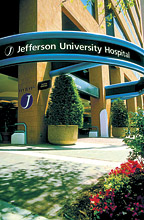While the Siemens APOGEE® BAS provides the control reliability the hospital needs, the platform also helps reduce both operational and utility costs. APOGEE's ease-of-use and Siemens' thorough training program make the building staff effectively self-sufficient, providing both time and cost savings. And thanks to the installation of a full-scale energy conservation program during the past year, the hospital also can claim savings of more than $1 million in utility costs, and counting.
"The upgraded system helped improve efficiencies for our department, as far as maintenance and operations goes," said Robert Ayling, facilities manager at Thomas Jefferson University. "It will continue to help in the long run, as well, as the cost of energy keeps rising, the continued energy savings will be important."

Client Objectives
For the university, protection of researchers, students, and patients hinges on one thing: reliability. As a BL3 AIDS research lab, the hospital is required to have a regulated number of air exchanges per hour during occupied times to protect occupants. At the same time, the hospital must also protect its valuable research: highly sensitive biological specimens can die quickly if precise environmental conditions are not maintained. The university needs this high level of control and corresponding documentation for compliance with Joint Commission on Accreditation of Health Care Organizations (JCAHO), AAALAC, and the Department of Health. At the same time, the facility manager and the control systems administrator both wanted a system that would be easy to upgrade, maintain, and install, for its technology-savvy staff.With 105 nodes in the network, Siemens integrated a wide range of equipment from various manufacturers, including York and Carrier chillers, Trane AHUs, lighting, and laboratory equipment, such as fume hoods. "Our BAS is much more user-friendly," said Ayling. "We do our own installation and repairs internally, so because the operators only have to understand one system, it helps increase the response time and efficiency."
Critical equipment and systems, such as medical gas units, large air handlers, incoming service lines from the electric company, and emergency transfer switches, are all set to alarm if performance strays outside of set parameters. Control room operators, mechanics, and supervisors receive alarms via Siemens' RENO remote monitoring system, increasing the team's response time.
Positive Shutdowns
Siemens helped the university program equipment to shut down or slow down based on time of day or occupancy schedules. Lighting and fume hood airflow in laboratories are cut back when rooms are not in use. In some buildings, fans shut down at night, and in others, airflow is reduced based on static pressure.Siemens also provided extensive training not just for system operation, but also for installation and programming. Equipment scheduling has contributed to more than $600,000 in energy savings during the first year.
Reporting feature provides documentation for proving that consistent temperatures, humidities, pressures, and airflows are maintained in critical environments. With redundancy in alarming, all problems are handled as quickly as possible, ensuring utmost reliability. Also, supervisors stay informed without having to seek out information. As a result of Siemens' training program and APOGEE's relatively easy-to-use interface, the university crew installs, maintains, and services about 90% of all equipment - and also programs the system, including point databasing. This self-sufficiency reduces operational costs.ES
